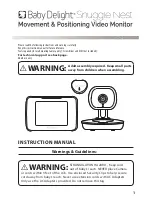
35
Q7: How should I clean the LCD surface?
Ans.:
For normal cleaning, use a clean, soft cloth.
For extensive cleaning, please use isopropyl
alcohol. Do not use other solvents such as
ethyl alcohol, ethanol, acetone, hexane, etc.
Q8: Can I change the color setting of my
monitor?
Ans.:
Yes, you can change your color setting
through OSD control as the following
procedures,
•
Press "OK" to show the OSD (On Screen
Display) menu
•
Press "Down Arrow" to select the option
"Color" then press "OK" to enter color
setting, there are three settings as below.
1.
Color Temperature; The six settings are
5000K, 6500K, 7500K, 8200K, 9300K
and 11500K. With settings in the 5000K
range the panel appears ‘warm,' with a
red-white color tone, while a 11500K
temperature yields ‘cool, blue-white
toning."
2.
sRGB; this is a standard setting for
ensuring correct exchange of colors
between different device (e.g. digital
cameras, monitors, printers, scanners, etc)
3.
User Define; the user can choose his/her
preference color setting by adjusting red,
green blue color.
Note:
A measurement of the color of light radiated by an
object while it is being heated. This measurement
is expressed in terms of absolute scale, (degrees
Kelvin). Lower Kevin temperatures such as 2004K
are red; higher temperatures such as 9300K are
blue. Neutral temperature is white, at 6504K.
Q9: Can I connect my LCD monitor to any PC,
workstation or Mac?
Ans.:
Yes. All Philips LCD monitors are fully
compatible with standard PCs, Macs and
workstations. You may need a cable adapter
to connect the monitor to your Mac
system. Please contact your Philips sales
representative for more information.
Q10: Are Philips LCD monitors Plug-and- Play?
Ans.:
Yes, the monitors are Plug-and-Play
compatible with Windows 7/Vista/XP/NT,
Mac OSX, Linux
Q11: What kind of wide-angle technology is
available?
Ans.:
Currently, the IPS type panels offer the best
Contrast Ratio, compared to MVA, or PVA
technologies. TN panels have improved over
the years, but IPS panel still gives superior
results over TN panel.
Q12: What is Image Sticking, or Image Burn-
in, or After Image, or Ghost Image in LCD
panels?
Ans.:
Uninterrupted display of still or static images
over an extended period may cause
"burn in", also known as "after-imaging"
or "ghost imaging", on your screen. "Burn-
in", "after-imaging", or "ghost imaging" is a
well-known phenomenon in LCD panel
technology. In most cases, the "burned in"
or "atter-imaging" or "ghost imaging" will
disappear gradually over a period of time
after the power has been switched off.
Always activate a moving screen saver
program when you leave your monitor
unattended.
Always activate a periodic screen refresh
application if your LCD monitor will display
unchanging static content.



































